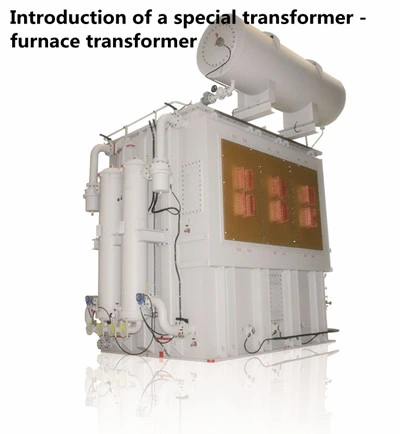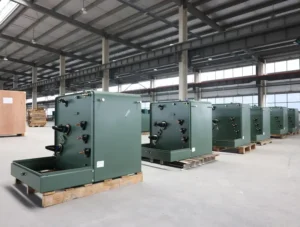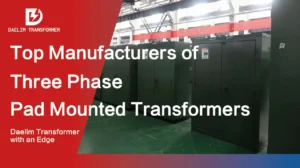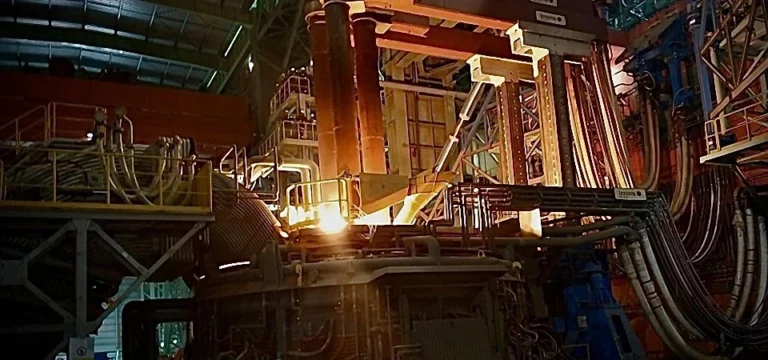Introduction of a special transformer - furnace transformer

The electric furnace transformer is the main equipment of the electric arc furnace. Its function is to reduce the input voltage, generate a large current, and supply the electric arc furnace. The load of the electric furnace transformer changes with time, and the current fluctuates greatly. Especially during the melting period, the electric furnace transformer is often in a peak load with a large inrush current. This article will introduce the knowledge of electric furnace transformer and the operation and maintenance of electric furnace transformer.
Pad-mounted Transformer
Dry-type Transformer
Oil immersed transformer
Table of Content
What is furnace transformer?
Electric furnace transformer is a special kind of transformer, which is generally used for transformers that mainly provide power to various electric furnaces. And reduce the high voltage to the working voltage required by the electric furnace. Pass generates a larger current.
You may interested in 1000 KVA Transformer Mini Substation Transformer Booming In NA Market
Types of furnace transformer
Divided by using
Electric furnace transformer for steelmaking
Transformer for electroslag furnace
Transformer for resistance furnace
Transformer for Salt Bath Furnace
Transformer for power frequency induction furnace
Divided by cooling method
Dry-type electric furnace transformer and oil-immersed transformer electric furnace transformer
Divided by the number fo phases
single-phase electric furnace
Three-phase electric furnace
Know more about 1000KVA PAD MOUNTED TRANSFORMER
How much does a furnace transformer cost?
Electric furnace transformers are special transformers, their structure is relatively complex, and corresponding technical capabilities are required for both design and production. Therefore, the price of electric furnace transformers is much higher than that of ordinary transformers, and accurate accounting should be carried out according to the technical requirements and parameters of the transformers.
Try for free 1500 kva Pad Mounted Transformer – DAELIM BELEFIC
What is the difference between an electric furnace transformer and an ordinary transformer?
1. Different overload capacity requirements.
The overload capacity of electric furnace transformers is much stronger than that of ordinary transformers.
2. The ability to resist short circuit is different.
In order to withstand working short circuit, the insulation, mechanical properties and impedance voltage of electric furnace transformers are stronger than ordinary transformers.
3. It is also required that the power supply transformer can adjust the voltage during operation.
How to test furnace transformer?
The following experimental items are generally done when the electric furnace transformer leaves the factory:
1. Measure the DC resistance of the winding and the bushing;
2. Check the transformation ratio of all taps;
3. Check the three-phase wiring group of the transformer and the polarity of the lead wire of the single-phase transformer;
4. Measure the insulation resistance, absorption ratio or polarization index of windings and bushings;
5. AC withstand voltage test of winding and bushing;
6. Measure the insulation resistance of each fastener insulated from the iron core and the lead-out sleeve of the iron core grounding wire to the shell;
7. Test of non-pure porcelain casing;
8. Insulating oil test;
9. Inspection and test of on-load voltage regulation switching device;
10. Impact closing test under rated voltage;
11. Check the phase;
How long do furnace transformers last?
Generally, electric furnace transformers with copper windings can be used for about 10 years. If the transformer is equipped with a device to eliminate harmonics, the service time can be longer.
Read my article on The Most Comprehensive Introduction to Dry Type 3000 kva Transformer
What happens when a furnace transformer goes bad?
Daelim is a professional electrical transformer supplier. It has a professional transformer technical team, and can customize various types of electrical transformers according to your parameters and technical requirements of the transformer. Daelim’s electrical transformers have been exported to the United States, Canada, Mexico, Australia, Chile, El Salvador, Panama, Ecuador and other North and South American regions. And won unanimous praise from customers for the quality of transformer products. If you also have electrical transformer needs, you can cooperate with Daelim with confidence.
Try for free information about the WHAT ARE THE STANDARD ACCESSORIES FOR PAD MOUNTED TRANSFORMER
What happens when a furnace transformer goes bad?
Generally, electric furnace transformers with copper windings can be used for about 10 years. If the transformer is equipped with a device to eliminate harmonics, the service time can be longer.
Let’s know learn more about the AUSTRALIA CUSTOMER
What happens when a furnace transformer goes bad?
Due to the harsh operating environment of the electric furnace and the complex manufacturing process of the transformer, unexpected problems often occur during field use. Here we take
A real case explains how to deal with the failure of electric furnace transformer.
This transformer is a submerged arc furnace transformer of a smelting company in Xining, Qinghai, with a capacity of 6300KVA and a voltage level of 10KV. One month after it was put into operation, the heavy gas protection action suddenly tripped, and the smelting work was forced to stop. Technicians from the transformer manufacturer arrived on site the next day and inspected the transformer immediately.
Keep on reading Basic Guide to Different Transformer Types
1. Preliminary inspection and fault analysis of electric furnace transformers
First of all, the possibility of the connection between heavy gas and light gas was ruled out before the inspection, and at the same time, it was confirmed that there was no misoperation of heavy gas. Since the transformer is designed with a hang-free structure, after the oil is drained, the box cover can be opened to see the condition of the transformer body. The transformer oil in the oil tank is as bright as new, the lead wires and wood blocks are intact, the pressure plate on the coil is not broken or displaced, and the coil is not bulging, but the coil cake can only be seen after it is not hung.
It is preliminarily inferred that the transformer has not suffered from overcurrent such as short circuit, and there may be a slight inter-turn or inter-segment short circuit in the transformer coil, which needs to be further determined.
2. The process of checking the fault
After the smelting work was stopped, the site environment has been greatly improved. At the same time, considering that there are cranes and oil filters on site, in order to reduce maintenance costs, shorten maintenance time, and reduce production losses, it was decided to carry out on-site maintenance of the transformer.
First, use a 1-inch steel pipe to weld a frame with a length, width and height of about 8m, seal it with a tarp, and place it on a clean ground. Several temporary lights are attached inside. After the transformer is hung, the body is placed in this frame, where all inspections and repairs are done. It can not only ensure that the device body is protected from moisture to the greatest extent, but also prevent dust from falling on it.
After the transformer body is hoisted out, a visual inspection is performed first, and it is found that there are some fine copper particles between the upper sections 5 and 6 of the A-phase high-voltage coil. Irradiate it with a flashlight, observe the signs of burning black between the 5th and 6th sections, and preliminarily judge that the fault point is here. There is no on-site transformer ratio test facility. To further identify the fault, add a 220V power supply, a 20A empty switch, a current transformer, an ammeter and a line to each tap of phase A.
First, power up between “A” and “1”. At this time, the number of turns between A-1 is 112, the voltage between turns is 1.96V/T, and the ammeter does not indicate. After that, the power cord on “1” does not move, and the original power cord on A is changed to “13, 11, 9…” respectively. When the power is turned on to “5-1”, the inter-turn voltage is 24.4V/T, the pointer of the ammeter suddenly becomes full offset, the trip is disconnected, and it is found that there is a gap between the 5th and 6th stages on the a-phase.
In order to determine whether the B-phase and C-phase coils are damaged, the above-mentioned methods are also used to energize the B-phase and C-phase respectively. Before measurement, short-circuit the A-phase low-voltage coil end to end to prevent the magnetic flux from flowing through the A-phase core column and avoid affecting the B and C-phase measurements. Turns out coils B and C are fine
You may interested in Basic Guide To GSU Transformer
Electric furnace transformer maintenance process
Only the upper part of the A-phase coil needs to be processed. After analysis and discussion, it was decided to put the A-phase coil on the mandrel and not hang it out. After the yoke is lifted out, first use gas welding to weld the low-voltage lead, then take out the low-voltage D1 line segment, put it into a clean plastic bag prepared in advance, and seal it well. Disconnect the line between Phase A A1 and A2, carefully remove the upper four segments of Phase A, and place in a clean plastic bag. Then disconnect paragraphs 6 and 7 and remove paragraphs 5 and 6.
It was found that the thin copper strip of the tap lead 9 of the 5th segment was bent and elongated, causing a “hump” in the oil passage and extending to the 6th segment. After the transformer is running, the coil vibrates, and the lead 9 keeps colliding with the segment 6. After a period of operation, the insulation was destroyed, causing the conductors in segment 6 to short-circuit.
Before the coil is wound, it is first mixed with transformer oil to form a dough, and the tiny copper particles attached to the coil, wire clip and iron core are adsorbed cleanly. Then several people worked together to wrap 5 or 6 sections on the mandrel by weaving back and forth, and each section was fixed with white cloth tape to make a tap lead. Then, restore the high and low voltage line segments, return to the iron yoke, and weld the low voltage lead and high voltage lead.
After processing, take an oxygen bottle and use the pressure of oxygen to blow off the attachments on the coil and iron core. Finally, after the body is processed, before loading into the cleaned oil tank, rinse it repeatedly with clean transformer oil, then put it into the oil tank, seal it well, and do not fill it with oil.
Electric furnace transformer drying treatment
There are many ways to dry transformers on site. Prepare induction heating for drying depending on the tools and environmental conditions available on site. It is known that the external voltage is 220V, the outer surface area of the fuel tank is about 14.4m2, the ambient temperature is 15°C, and the coefficient k is 8. After calculation: excitation power P=10KW. The power consumption per unit area △P=0.9KW/m2, the outer turns of the box wall W=74, and the excitation current I=54A.
First, cover the sides and top of the fuel tank with asbestos cloth that can be found on site. The role of the asbestos cloth is to keep the transformer body warm. Then use 35mm2 copper cable to wrap 74 turns from the bottom of the tank to the top, and about 45 turns to the lower half. It is fixed after winding, and the start and end points are controlled by the empty switch.
8 slender 2000W resistance wires are connected in parallel at the bottom of the fuel tank, fixed on the refractory bricks through the binding posts, about 100mm from the bottom of the fuel tank, and individually controlled by connecting an empty one. Several mercury thermometers are attached to the upper and lower sides of the tank side wall. The temperature in the fuel tank is measured through the pressure relief valve port, and the lead wire for measuring the insulation of the iron core is led out from the pressure relief valve port. Usually, the pressure relief valve port is sealed with a cover plate, and it is opened when the temperature is measured and the humidity is released.
After applying 220V voltage for 12 hours, the temperature of the box wall thermometer rose to about 98°C, and the temperature in the box was lower than the temperature of the box wall at the beginning. After about 20 hours, the temperature inside and outside is quite hot, maintaining around 95 ℃. During this period, the change of insulation was observed and recorded every 1 hour with a 2500V megohmmeter. At first, due to the large amount of evaporated water vapor, it adhered to the surface of the insulation layer and was not discharged. Insulation resistance is low and then slowly rises.
During this process, open the pressure relief valve port at regular intervals to release the water in the fuel tank, measure and record the temperature in the fuel tank and the insulation resistance of the iron core. See Figure 3 (1 is the insulation drying curve of the high voltage winding; 2 is the insulation drying curve of the low voltage winding; 3 is the iron core insulation drying curve).
After 70 hours, the insulation resistance is stable above 2500M. Then cut off the power supply, remove the excitation wire, asbestos cloth, resistance wire, etc. After cleaning the site, open the box cover and the low-voltage lead installation hand hole, check and tighten the fastening nut that may be loose due to drying, and fix the core grounding plate at the same time. Then close the cover and tighten the cover nuts. Install pressure relief valve. Fill in filtered transformer oil.
Furnace transformer test and power up work
After one day of refueling, the field acceptance test of resistance, insulation and withstand voltage was carried out, and there was no problem. Put the transformer back in its working position, connect the short grid, power up the furnace, and everything is fine.
How often furnace transformer maintenance?
1. Furnace transformer maintenance cycle
1) Additional maintenance is required for the standby transformer before it is put into operation.
2) The transformers in operation or standby are routinely maintained once a year.
2. Operation steps for primary maintenance of electric furnace transformer
Run for about half a year, and carry out first-level maintenance operations, including routine maintenance of various contents
1) Release the dirty oil in the dirt accumulator of the oil conservator;
2) Check the oil level gauge and adjust the oil level;
3) Check whether the cooling device operates normally and there is no leakage;
4) Check the safety protection device;
5) Check the oil protection device;
6) Check whether the indication of the temperature measuring device is normal;
7) Check whether the indication of the pressure regulating device is consistent, the wiring in the control box is not loose or falling off, and carry out the transmission test;
8) Check whether the grounding device is well grounded;
9) Check all valves and seals for no leakage;
10) Clean the fuel tank and accessories, and repaint if necessary;
11) Clean the outer insulation and check that the conductive head has no heat;
12) Measure and test according to relevant regulations;
3. Operation steps for secondary maintenance of electric furnace transformer
After about 4 years of operation, carry out secondary maintenance operations, including the contents of primary maintenance
1) Lift the bell to overhaul the body, or lift out the body for overhaul;
2) Overhaul of windings, leads and magnetoelectric shielding;
3) Overhaul of iron core, iron core fasteners, pressure nails, pressure plates and grounding sheets;
4) Overhaul of fuel tank and accessories, including casing, moisture absorber, etc.;
5) Maintenance of ancillary equipment such as coolers, oil pumps, fans, valves and pipes;
6. Overhaul of safety protection devices;
7) Maintenance of oil protection device;
8) Overhaul of the temperature measuring device;
9) Overhaul and test of operation control box;
10) Maintenance of off-excitation tap-changer or on-load tap-changer;
11) Replacement of all gaskets and overhaul of components;
12) Drying of the body;
13) Disposal or replacement of transformer oil;
14) Clean the fuel tank and paint;
15) Test and trial operation after overhaul;
Read my article on How to Choose a Pad Mounted Transformer and Delta Wye Transformer?
Daelim Furnace Transformer Project Case
In 2018, Daelim exported two furnace transformers to Mexico,20kV 6MVA and 20mva furnace transformer. The customer uses it in his own steelmaking plant. Since the current transformer has been used for a long time, it needs to be replaced. Therefore, the customer found Daelim Transformer Company, and it was our Spanish colleague Elena who communicated with him in Spanish. Daelim’s professionalism has won the trust of the client, and the client invited Daelim’s team to go to Mexico to discuss and confirm technical issues.
Elena traveled to Mexico with our transformer engineer. The customer is a local steel-making enterprise with a century-old history. The selection of transformer suppliers is very rigorous and meticulous. After three or four days of technical communication and confirmation, Daelim engineer’s technical expertise and service, the customer gave Daelimn the contracts for the two electric furnace transformers. The two electric furnaces went into smooth production. The customer also came to China for on-site inspection before delivery, and the customer was very satisfied. At present, these two electric furnaces are in normal and safe operation in Mexico.
If you also have projects and needs for electric furnace transformer, you can contact the Daelim team.













